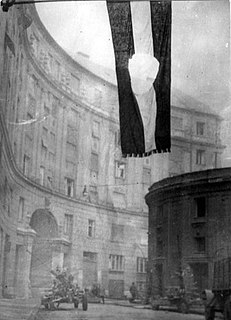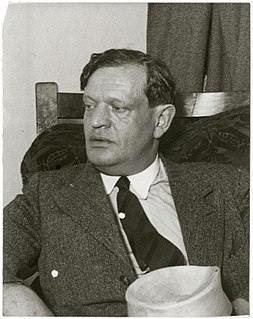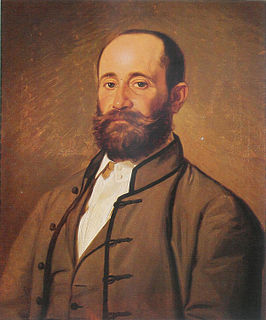
Austria-Hungary, often referred to as the Austro-Hungarian Empire or the Dual Monarchy, was a constitutional monarchy and great power in Central Europe between 1867 and 1918. It was formed with the Austro-Hungarian Compromise of 1867, and was dissolved following its defeat in the First World War.

The Central Powers, also Central Empires, consisting of Germany, Austria-Hungary, the Ottoman Empire and Bulgaria – hence also known as the Quadruple Alliance —was one of the two main coalitions that fought World War I (1914–18).

Hungary is a country in Central Europe. Spanning 93,030 square kilometres (35,920 sq mi) in the Carpathian Basin, it borders Slovakia to the north, Ukraine to the northeast, Romania to the east and southeast, Serbia to the south, Croatia and Slovenia to the southwest, and Austria to the west. With about 10 million inhabitants, Hungary is a medium-sized member state of the European Union. The official language is Hungarian, which is the most widely spoken Uralic language in the world, and among the few non-Indo-European languages to be widely spoken in Europe. Hungary's capital and largest city is Budapest; other major urban areas include Debrecen, Szeged, Miskolc, Pécs, and Győr.

Hungarian is a Uralic language spoken in Hungary and parts of several neighbouring countries. It is the official language of Hungary and one of the 24 official languages of the European Union. Outside Hungary it is also spoken by communities of Hungarians in the countries that today make up Slovakia, western Ukraine (Subcarpathia), central and western Romania (Transylvania), northern Serbia (Vojvodina), northern Croatia, northeastern Slovenia and eastern Austria.

Budapest is the capital and the most populous city of Hungary, and the ninth-largest city in the European Union by population within city limits. The city has an estimated population of 1,752,286 over a land area of about 525 square kilometres. Budapest is both a city and county, and forms the centre of the Budapest metropolitan area, which has an area of 7,626 square kilometres and a population of 3,303,786, comprising 33% of the population of Hungary.

Miklós Horthy de Nagybánya was a Hungarian admiral and statesman, who became the regent of Hungary. He served as regent of the Kingdom of Hungary between World Wars I and II and throughout most of World War II, from 1 March 1920 to 15 October 1944. He was styled His Serene Highness the Regent of the Kingdom of Hungary, Hungarian: Ő Főméltósága a Magyar Királyság Kormányzója.

Countess Elizabeth Báthory de Ecsed was a Hungarian noblewoman from the noble family of Báthory, who owned land in the Kingdom of Hungary.

Radio Free Europe/Radio Liberty (RFE/RL) is a United States government-funded organization that broadcasts and reports news, information and analysis to countries in Eastern Europe, Central Asia and the Middle East where it says that "the free flow of information is either banned by government authorities or not fully developed". RFE/RL is a 501(c)(3) corporation supervised by the U.S. Agency for Global Media, an agency overseeing all U.S. federal government international broadcasting services.

The Hungarian Revolution of 1956, or the Hungarian Uprising, was a nationwide revolution against the Hungarian People's Republic and its Soviet-imposed policies, lasting from 23 October until 10 November 1956. Leaderless at the beginning, it was the first major threat to Soviet control since the Red Army drove Nazi Germany from its territory at the End of World War II in Europe.

Vlad III, known as Vlad the Impaler or Vlad Dracula, was Voivode of Wallachia three times between 1448 and his death. He is often considered one of the most important rulers in Wallachian history and a national hero of Romania.

Péter Nádas is a Hungarian writer, playwright, and essayist.

Melchior Lengyel was a Hungarian writer, dramatist, and film screenwriter of Jewish heritage.

The Alliance of Vojvodina Hungarians, is an ethnic Hungarian political party representing the Hungarian minority in Serbia, primarily active in the province of Vojvodina.

Frigyes Karinthy was a Hungarian author, playwright, poet, journalist, and translator. He was the first proponent of the six degrees of separation concept, in his 1929 short story, Chains (Láncszemek). Karinthy remains one of the most popular Hungarian writers. He was the father of poet Gábor Karinthy and writer Ferenc Karinthy.

Jakov Ignjatović was a novelist and prose writer, who primarily wrote in Serbian but also in Hungarian.

Magda Szabó was a Hungarian novelist. Doctor of philology, she also wrote dramas, essays, studies, memoirs, poetry and children's literature. She is a founding member of the Digital Literary Academy. She is the most translated Hungarian author, with publications in 42 countries and over 30 languages.

Archduke Franz Ferdinand Carl Ludwig Joseph Maria of Austria was the heir presumptive to the throne of Austria-Hungary. His assassination in Sarajevo is considered the most immediate cause of World War I.

Gyula Krúdy was a Hungarian writer and journalist.

The Church of St. Stephen of Hungary was a Roman Catholic parish church in the Roman Catholic Archdiocese of New York, located at 402-412 East 82nd Street, Manhattan, New York City. It was administered by the Order of Friars Minor from its founding in 1922 until the merger of the parish took place in 2015.

Lajos Parti Nagy Kossuth Prize winner Hungarian poet, playwright, writer, editor, critic, one of the founding members of the Digital Literary Academy.




















